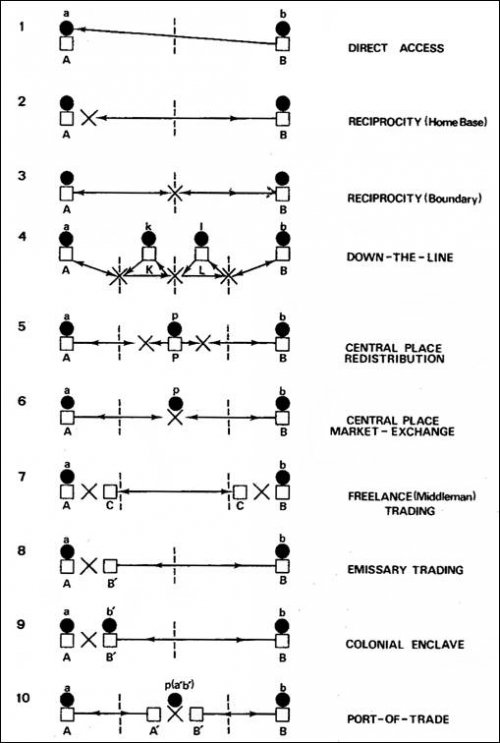Geographical characteristics
Renfrew (1975) considers trade as interaction between communities in terms of both energy and information exchange. Renfrew (1975: 8) tabulated Polanyi's schema as follows
|
Configuration |
Geographical |
Affiliation |
Solidarity |
|
|
Reciprocity: |
Symmetry |
No Central Place |
Independence |
Mechanical |
|
Redistribution: |
Centricity |
Central Place |
Central Organization |
Organic |
Table 2-3. Characteristics of reciprocity and redistribution (from Renfrew 1975: 8).
Renfrew follows with an exploration of the greater efficiency implied by central place organization in terms of material and information exchange. The universality of central place organization in the development of complex political organization worldwide has been called into question in pastoral settings. In the south-central Andes, anthropologists have proposed that alterative paths to complex social organization could have been pursued by distributed communities linked by camelid caravans with the anticipated central place hierarchy not occurring until relatively late, as proposed by Dillehay and Nuñez (1988) and in a different form by Browman (1981).
Renfrew has developed a graphical representation of the spatial relationships implied by each mode of exchange.
Figure 2-2. Modes of exchange from Renfrew (1975:520) showing human agents as squares, commodities as circles, exchange as an 'X', and boundaries as a dashed line.
The exchange modes depicted by Renfrew (1975:520), shown in Figure 2-2, efficiently convey the variety in organization represented by exchange relationships. In some regions of the world, such as the prehispanic south-central Andes, market-based economies are not believed to have operated which modifies one's expectations for the activities of traders. The full suite of these ten modes is not expected in any one particular archaeological context worldwide, but the figure serves to underscore the complexity of isolating particular types of exchange based on archaeological evidence. Furthermore, these modes are not necessarily mutually exclusive, as some of these modes may have been operating simultaneously unless restrictions on production, circulation, or consumption of goods were in place.

